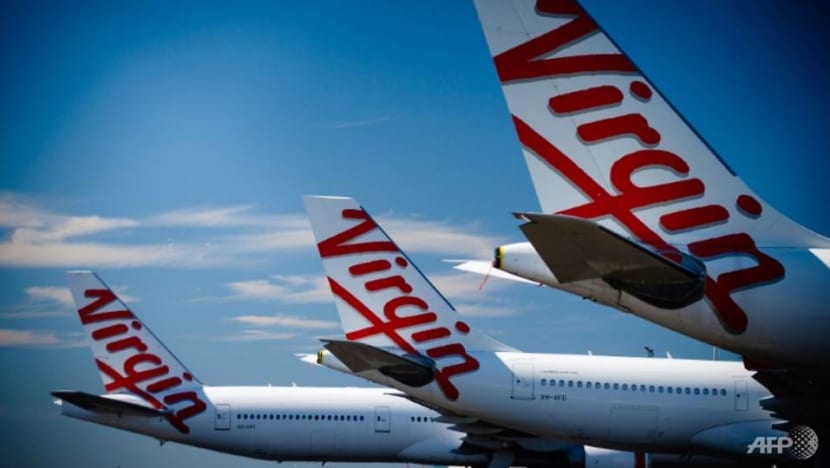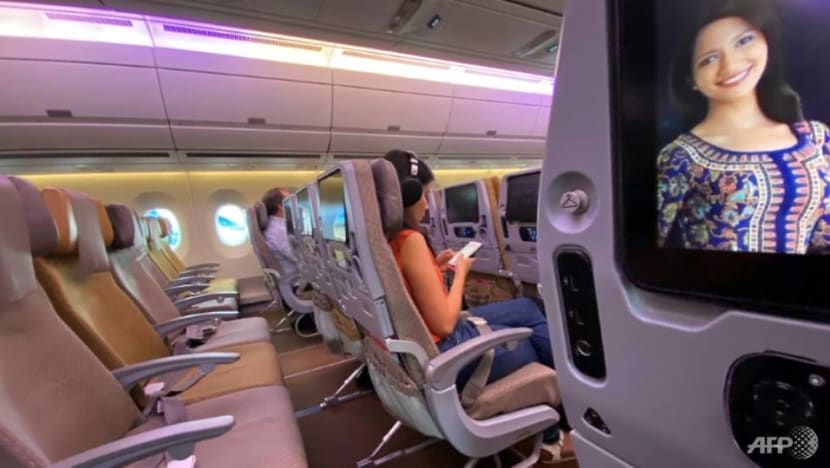commentary Commentary
Commentary: Airline industry faces financial crisis with more bankruptcies looming
More airline bankruptcies are inevitable as debts mount and revenues recover very slowly, says Brendan Sobie.

(Photo: AFP/Patrick HAMILTON)
SINGAPORE: The bottom for the global airline industry in terms of passenger traffic has passed but the financial implications from COVID-19 have only just started and bankruptcies are likely to continue at a steady clip over the next two years.
Global air passenger traffic bottomed out in April with a 94.3 per cent drop in revenue passenger kilometres compared to a year ago, based on International Air Transport Association (IATA) data.
PROFITABILITY A DISTANCE WAY
The second quarter will be a low point in terms of profitability with record losses to be reported by airlines from all markets except China, which bottomed out in February.
IATA is projecting US$84 billion in losses for 2020, marking by far the worst annual financial result in aviation history, on the back of revenues of only US$419 billion - a 50 per cent drop from 2019.
READ: Commentary: To help us travel safer with COVID-19, airports need new checkpoint technology
While the losses should start moderating in the third quarter as traffic and revenues slowly improve driven mainly by recovering domestic markets, it could take at least two years for the industry to return to profitability based on the expected time it will take for the international market to recover.
Most airlines cannot be profitable without a full, or almost full, recovery of international air travel, which is not likely until there is a vaccination.
Airlines everywhere face a long gruelling battle to survive a prolonged downturn with revenues that will remain insufficient to cover costs – even with significant cost cutting – until there is a vaccination.
Financial pressure will intensify as losses continue, forcing more airlines into bankruptcy.

Debt levels are rising rapidly, creating a mountain that airlines may not be able to climb given the expected slow return to profitability and the several years it could take for many airlines to achieve a profit margin sufficient to cover interest and bond payments.
LEASING COSTS DUE
Over the next several months airlines will also have to contend with a rise in aircraft leasing costs and wages despite reductions in fleet size and head count.
Most airlines have not been making aircraft lease payments, one of their largest cost lines, for the last three months after negotiating initial deferrals with leasing companies.
These deferrals are starting to expire and even if they are extended for a few more months, airlines will eventually have to resume making monthly payments plus make up for the missed payments with interest.
Double payments in some cases will be required but even spreading out the missed payments over a long period could have a disastrous impact given revenues will remain low and a large portion of the fleet will remain grounded for at least a couple of years.
READ: Commentary: We will fly again. Here’s what’s needed to safely restart flights and resume air travel
Some airlines are trying to negotiate payment waivers in exchange for longer leases but so far there are very few such deals and leasing companies cannot easily offer such relief except for older aircraft with leases that are about to expire and would be difficult to remarket.
Extending deferrals beyond six months is also challenging for many aircraft leasing companies, which could struggle to survive for much longer with virtually no revenues.
Airlines may be able to negotiate partial payments, which will help the leasing companies meet their own commitments, while delaying the resumption of full payments and the payback of the missed months plus interest.
However, such agreements would make it even harder to achieve the hoped for return to profitability in 2022 or 2023 as payments will eventually have to be made up, potentially contributing to bankruptcies even if demand for air travel improves.
WAGE SUPPORT RUNNING OUT
The issue of increasing labour costs is driven by the expiration of government wage subsidy or job protection schemes.

For the last few months more than 30 major countries have been providing airlines and other types of impacted companies subsidies that cover up to 80 per cent of salaries although with a cap that limits the coverage for high paying jobs such as pilots.
In many countries these subsidies will soon expire, leading to job cuts which some airlines have already announced to meet notice requirements for impacted employees and unions.
Those airlines that have not yet cut jobs will have little choice but to announce cuts if governments do not extend the schemes.
Given the expected long duration of this downturn, most airlines will not need staffing levels to return to pre-pandemic levels until at least 2022 or 2023.
As it is not realistic for governments to cover the wages of surplus workers for a couple of years, significant job cuts are unfortunately inevitable at virtually every major airline.
READ: Commentary: Domestic travel in Asia Pacific not hitting full speed yet as consumers slow to return to the skies
The expiration of wage subsidies will also impact the cost of employees that are being retained, leading in some cases to an overall higher wage bill despite the reduction in head count.
OTHER COST INCREASES
Other costs will increase in the coming months as benefits from government support packages as well as concessions from suppliers expire.
For example, airlines have been paying reduced charges, fees and taxes in most countries.
Over 30 countries are also providing financial support to airlines, which in several cases have resulted in new or increased government equity stakes.
Financial support packages, which often include loans or loan guarantees, are longer lasting than wage subsidies and other benefits but in most cases the funds provided are not sufficient for a prolonged downturn and could prompt airlines to ask for second packages in 2021 or 2022.
READ: Commentary: To facilitate regional air travel again, ASEAN needs to harmonise standards
Some governments may not be willing to bail out airlines a second time, leading to another string of bankruptcies.

Several airlines have already entered bankruptcy protection or administration since the start of the pandemic, including Aeromexico, Air Mauritius, Avianca, South Africa’s Comair, LATAM Airlines, Thai Airways and Virgin Australia.
With all of them, the failure to secure financial support from their governments was the main driver.
All seven are expected to successfully emerge from bankruptcy or administration and survive following restructurings.
Three airlines have ceased operations entirely and are in the process of being liquidated – Austria’s LEVEL Europe, Germany’s SunExpress Deutschland and Thailand-based NokScoot – but they were small subsidiaries of much larger parents that continue to operate.
There have been other collapses since March involving airlines that were already in bankruptcy or administration prior to the pandemic or small regional aircraft operators.
GOVERNMENT SUPPORT KEY
However, a total of 10 bankruptcies and liquidations among Airbus and Boeing operators in the first four months of the pandemic is not concerning given that even in a typical year this would not be an unusually high number.
Back in March, some observers warned there could be mass airline bankruptcies by the end of May, an outcome which was averted due to over US$100 billion in government financial support packages globally.
READ: Commentary: COVID-19, the biggest crisis ever for Singapore’s aviation industry and Singapore Airlines
For the rest of this year airline bankruptcies are particularly likely in Africa and Latin America as countries in these regions have generally refused to provide airlines with any significant support.
Latin America’s three largest airline groups - Aeromexico, Avianca and LATAM - have all entered US Chapter 11 bankruptcy protection, which enables them to cancel contracts – including aircraft leases and orders - and restructure.

Competitors are at a disadvantage as they cannot adapt as easily, leading to more Chapter 11 filings even if they have the ability to secure capital privately.
SOME CONSOLIDATION IN ASIA
In Asia several major countries also have not yet provided any financial support to airlines, including India, Malaysia and Philippines.
There is still hope these key Asian countries will step up to the plate. For example, AirAsia expects to secure government loan guarantees in Malaysia and the Philippines, helping to support an overall restructuring that also includes a planned equity sale and renegotiated aircraft lease agreements.
Asia’s independent low-cost carriers (LCCs) are currently at a disadvantage because thus far the bailout packages by Asian governments have only benefitted full service airlines and their LCC subsidiaries.
READ: Commentary: Novel coronavirus turns 2020 into a bleak year for Asian airlines
A few more Asian LCCs could shut down, joining NokScoot, including some of the nine airlines that operate under the AirAsia brand. However, most should be able to survive given their strong presence in domestic markets, which will recover first, and their strong brands.
The void from any casualties in Asia’s LCC sector will also likely be filled by surviving airlines and start-ups.
Mergers and acquisitions are also a possible outcome from the COVID-19 crisis but in the short term these are not likely as airlines are focused on their own survival. In fact, some airline groups have been shedding stakes in overseas airlines rather than using this period to buy new stakes or pursue acquisitions.
In Asia there are still several barriers to consolidation, including foreign ownership restrictions.

Consolidation would be a healthy outcome globally and particularly in Asia, where several markets were already suffering from overcapacity and irrational competition before the pandemic.
However, several airlines in Asia and other regions that were struggling before COVID-19 now have a new lease of life due to government bailouts that would have been harder to secure if it were not for the pandemic.
While the bailouts were necessary given the critical role of airlines in the overall economy they distort the playing field and could make it harder for the overall industry to return to profitability.
The global airline industry faces a long tough road in the years ahead.
Brendan Sobie is the founder of Singapore-based independent aviation consulting and analysis firm Sobie Aviation. He was previously chief analyst for CAPA – Centre for Aviation.














